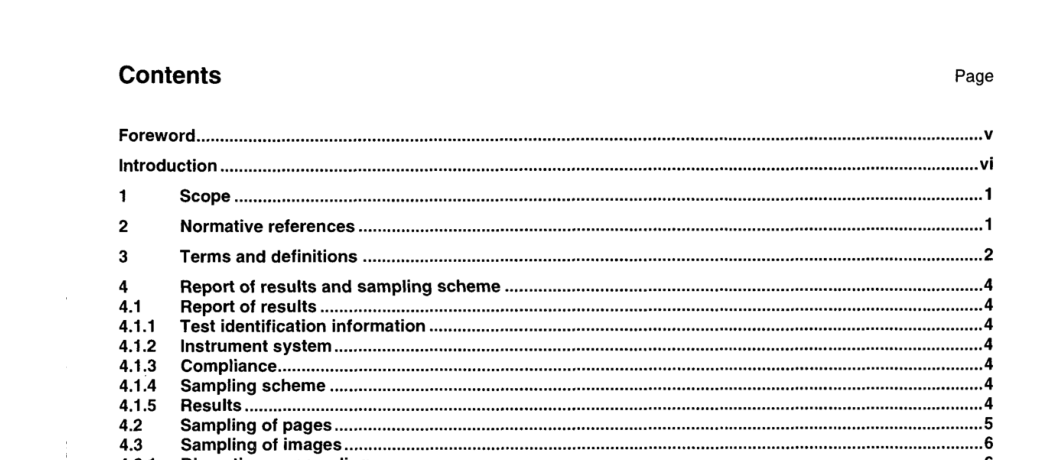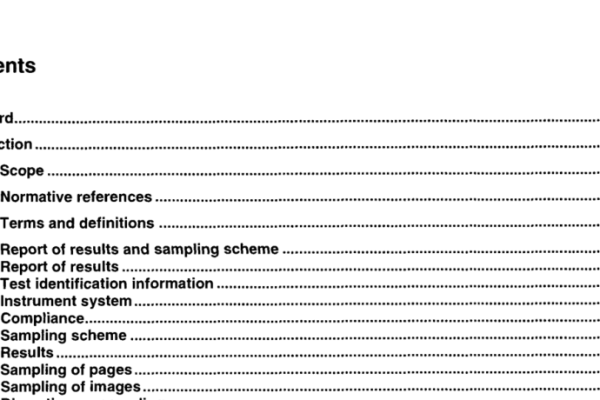ISO IEC 13660:2001 pdf download – Information technology – Office equipment – Measurement of image quality attributes for hardcopy output – Binary monochrome text and graphic images.
1 Scope This International Standard specifies device-independent image quality attributes, measurement methods, and analytical procedures to describe the quality of output images from hardcopy devices. This International Standard is applicable to human-readable documents composed of binary monochrome images produced from impact printers, non-impact printers, and copiers. The attributes, methods, and procedures rely on intrinsic properties of the image. Targets or reference images are not required. The International Standard is not applicable to images on media other than hardcopy (e.g. images on a VDT) or to images that are intended to be machine readable only (e.g. bar codes). This International Standard is not intended to apply to pictorial art. It is optimized for black colourant forming the image on a white substrate; it is not intended to be used for dropped out or reversed type or for transparencies. The evaluation of an image with any other colour of colourant or substrate will be sensitive to changes in illumination. In this case, the procedures of this International Standard may not be applicable and should be used with caution. 2 Normative references The followina normative documer..s c n this International Standard. For dated lin provisions which, through reference in this text, constitute provisions of references, subsequent amendments to, or revisions of, any of these publications do not apply. However, parties to agreements based on this International Standard are encouraged to investigate the possibility of applying the most recent editions of the normative documents indicated below. For undated references, the latest edition of the normative document referred to applies. Members of IS0 and IEC maintain registers of currently valid International Standards. IS0 5-1 : 1984, Photography – Density measurements – Part 1: Terms, symbols and notations IS0 5-3: 1995, Photography – Density measurements – Part 3: Spectral conditions IS0 5-4: 1 995, Photography – Density measurements – Part 4: Geometric conditions for reflection density CIE 15.2:1986, Colorimetry TAPPI T480 om-92, Specular gloss of paper and paperboard at 75 degrees TAPPI T452 om-92, Brightness of pulp, paper, and paperboard (directional reflectance at 457 nm)
3 Terms and definitions For the purposes of this International Standard, the following terms and definitions apply. The image quality attributes themselves are defined in Clause 5. binary- any system based on exactly two possible values, such as 0/1 or blaclúwhite. binary image- an image with only two fundamental tones: the substrate and the colourant. boundary- the region of an edge within which the reflectance factor makes the transition from 10% to 90% of the difference between image and substrate reflectance factors. See also threshold contour. character image- a specific physical representation of a character glyph. colourant- the material used to make an image visible. In copying and electronic printing, the two main colourants are dye and pigment. density, optical- log1 O (l/ß), where ß is the reflectance factor, measured according with O/45-degree geometry, Illuminant A, and IS0 visual density calibration. dictortion- undesired change in the shape of an image.
ISO IEC 13660:2001 pdf download – Information technology – Office equipment – Measurement of image quality attributes for hardcopy output – Binary monochrome text and graphic images






